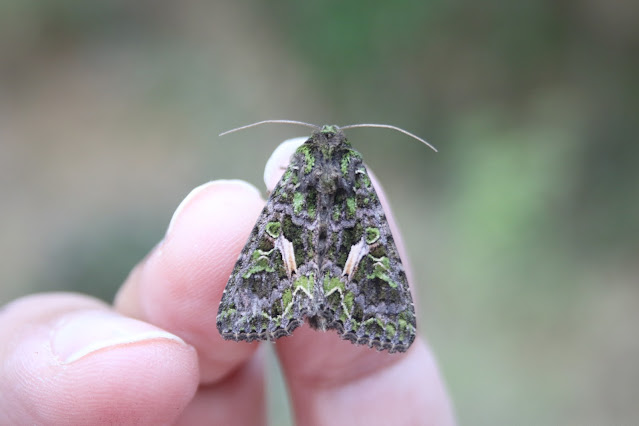A nice and relaxed couple of last days in Bulgaria. On Friday I met up with Dimiter and Marina at the Tango in Kamen Bryag and spent the evening checking out the habitat above Yailata and looking for Olive-tree Warblers which have a small colony here. I had one bird singing briefly but obviously mid-summer, when birds are moulting/feeding young, is not the best time of year to look for them. The plan for next Spring is to do a later visit than usual (mid-May) which will be a good time to look for them again and also target a later part of the Spring, which should be better for a later suite of migrants and early summer moths too.
On my last day I did the moths first thing as usual and then spent most of the day at Yailata again but in the main reserve this time along the coast. In the afternoon, after lunch at the Mopko I headed back to Varna for the flight back to London.
Despite having mobile wifi, the signal was not great and I wasn't able to work through I-naturalist and Lepiforum for identifications so I've got quite a bit of post-trip work to do to catch up with this.
Some photos below of some of the highlights with identifications to follow.
'Mediterranean' Shags at Yailata. Adults and a second-calendar year bird showing off it's moult limits
Pied Wheatears- this time of year the males are at their maximum 'Pied' appearance before they moult into winter plumage
I may have been presumptuous over the Lappets I'm getting here. According to lepiforum there are four larger Lappet species in Bulgaria including
Phyllodesma tremulifolia, P.ilicifolia,
Gastropacha quercifolia and
G. populifolia, with vernacular names of Oak Mother Hen, Willow Mother Hen, Copper Mother Hen and Poplar Mother Hen respectively.
There are actually 14 species of 'Lappets' across Europe, I've recorded Aspen and Plum on road trips before
HERE. The one above is one of the large long snouted species so either Poplar or Copper. In Copper,
quercifolia (the species we get in the UK) the ground colour is richer and the markings are contiguous zig-zags where in Poplar the ground colour is more orange-yellow with dark broken markings, so this looks more like Poplar but could be a slightly worn Copper? The habitat in the area is more suitable for Copper.
Many-lined
Cyclophora albicellaria - a southeast Europe and Central Asian species
Surprisingly the image recognition on I-naturalist doesn't suggest anything for this rather distinctive looking moth. 110723 Update: i-naturalist experts have identified this as Dichagyris candelisequa
Maybe Eublemma suava
Purple-barred Yellow
Eilicrinia trinotata
Orache Moth
There are two similar looking 'Least Carpets' in the region, Idaea filicata and rusticata (Least). Filicata is more glossy with spots and more squared off dark markings. This one looks like a Least.
Dichagyris melanura- a southeast European species
Closest I can get to this is a Euxoa sp, maybe temera
Epicallima icterinella
I think these are Southern Migrant Hawker, female (above) and male (below).
Not sure - maybe a female Vagrant Emperor
A couple of Blues from the plot (yet to id) . Maybe Iolas Blue (above).
The cliffs at Yailata, the famous archaeological site - there are numerous routes down to the sea from the Yailata wave cut platform- probably why this site has been occupied throughout prehistory, antiquity and into more recent times
Quite an adequate little set up for now - water should be on site by August and if we get some kind of temporary toilet facilities, well we can start calling it a holiday home (sort of). In the longer term we want to build a wooden cabin. We already got an electricity connection and once we have the water connection (in August), should be ready to go onto the next stage.






















No comments:
Post a Comment